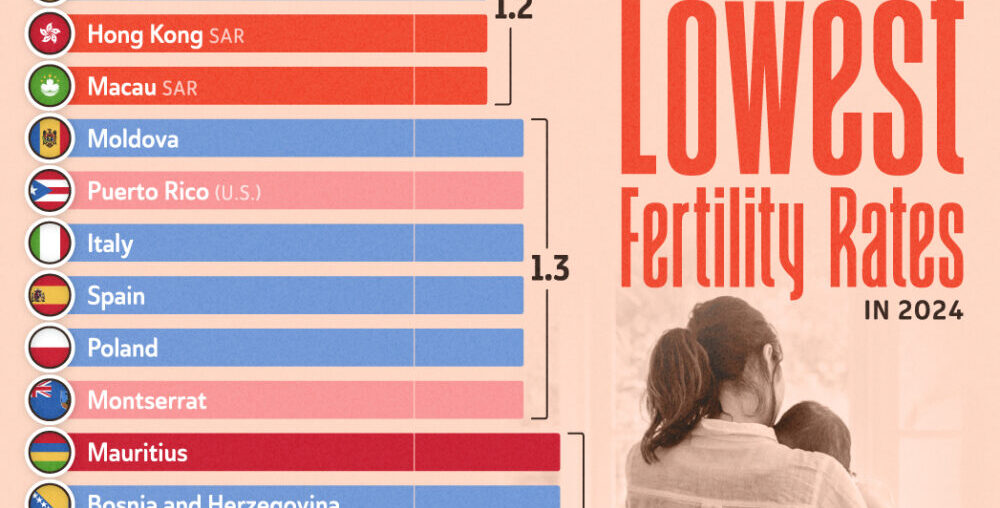The 20 Countries With the Lowest Fertility Rates in 2024
This was originally posted on our Voronoi app. Download the app for free on iOS or Android and discover incredible data-driven charts from a variety of trusted sources.
Worldwide, fertility has fallen from an average of 5 births per woman in 1950 to 2.3 births per woman in 2021.
With fewer children being born, concerns have arisen that there may soon be ‘too few’ people to sustain economies.
This graphic lists countries with the lowest fertility rates as of 2024, based on data compiled by Statista. All figures are estimates.
Understanding Fertility Rate
The fertility rate refers to the average number of children born to a woman of childbearing age in a given country. Typically, women between the ages of 15 and 45 are considered to be in their child-bearing years.
A fertility rate of 2.1 children per woman, known as the “replacement rate,” keeps the population stable by replacing both parents and accounting for infant mortality—assuming no migration and stable mortality rates.
Taiwan’s fertility rate is estimated at 1.11 children per woman, the lowest in the world.
| Region | Country | Children per Woman |
|---|---|---|
| Asia | 🇹🇼 Taiwan | 1.1 |
| Asia | 🇰🇷 South Korea | 1.1 |
| Asia | 🇸🇬 Singapore | 1.2 |
| Europe | 🇺🇦 Ukraine | 1.2 |
| Asia | 🇭🇰 Hong Kong SAR | 1.2 |
| Asia | 🇲🇴 Macau SAR | 1.2 |
| Europe | 🇲🇩 Moldova | 1.3 |
| North America | 🇵🇷 Puerto Rico (U.S.) | 1.3 |
| Europe | 🇮🇹 Italy | 1.3 |
| Europe | 🇪🇸 Spain | 1.3 |
| Europe | 🇵🇱 Poland | 1.3 |
| North America | 🇲🇸 Montserrat | 1.3 |
| Africa | 🇲🇺 Mauritius | 1.4 |
| Europe | 🇧🇦 Bosnia and Herzegovina | 1.4 |
| North America | 🇻🇬 British Virgin Islands | 1.4 |
| Asia | 🇯🇵 Japan | 1.4 |
| Europe | 🇬🇷 Greece | 1.4 |
| North America | 🇨🇷 Costa Rica | 1.4 |
| North America | 🇧🇸 Bahamas | 1.4 |
| Europe | 🇧🇾 Belarus | 1.4 |
| — | 🌍 Global Average | 2.3 |
Europe leads the ranking with eight countries, followed by Asia with six, North America with five, and Africa with one.
Europe is also the only region in the world expected to experience an overall population decrease in the near term (between 2022 and 2050), with a projected decline of 7%.
In contrast, populations in other regions—including Central, South, and Southeast Asia, Latin America and the Caribbean, and North America—are expected to continue growing but will reach their peak populations before 2100.
Still, countries with low fertility rates have taken measures to mitigate the eventual impact on their economies.
For example, South Korea has started allowing families to hire foreign nannies to encourage higher birth rates.
Meanwhile, Japan has allocated as much as 3.6 trillion yen (US$22.3 billion) annually in an effort to reverse the trend.
Learn More on the Voronoi App 
To learn more about fertility around the world, check out this graphic that shows when the world will reach its peak population.

